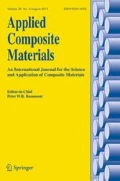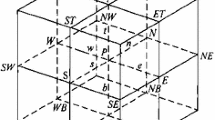Abstract
Voids formed during liquid composite molding significantly degenerates mechanical performances of the final products, accurate prediction of the formation and size of void has significance for the parameter design of LCM. However, the 3D simulation method of void formation, in which the complex interconnecting of pores can be fully considered, has not been developed. In order to analyze the meso-scale-void formation process in full dimensionality, the mechanisms of dual-scale flow and void formation are analyzed firstly in this paper, then the mathematical models for the two-phase inter-tow and intra-tow flow are established based on the VOF theory. During numerical solving, the 3D geometry model is used and the momentum source of capillary force is updated in real-time to guarantee the simulation accuracy. The simulated formation process and size of meso-scale-void are compared with experimental results to verify the effectiveness and correctness of the developed method.












Similar content being viewed by others
References
Liu, B., Bickerton, S., Advani, S.G.: Modelling and simulation of resin transfer moulding (RTM)- gate control, venting and dry spot prediction. Composite Part A. 27(2), 135–141 (1996)
Han, K., Lee, L.J.: Dry spot formation and changes in liquid composite molding: I- experimental. J. Compos. Mater. 30, 1458–1474 (1996)
Han, K., Lee, L.J., Nakamura, S., Shafi, A., White, D.: Dry spot formation and changes in liquid composite molding: II- modeling and simulation. J. Compos. Mater. 30(13), 1475–1493 (1996)
Rohatgi, V., Patel, N., Lee, L.J.: Experimental investigation of flow induced microvoids during impregnation of unidirectional stitched fiberglass mat. Polym. Compos. 17(2), 161–170 (1996)
Patel, N., Rohatgi, V., Lee, L.J.: Micro scale flow behavior and void formation mechanism during impregnation through a unidirectional stitched fiberglass mat. Polym. Eng. Sci. 35(10), 837–851 (1995)
Park, C.H., Lee, W.I.: Modeling void formation and unsaturated flow in liquid composite molding processes: a survey and review. J. Reinf. Plast. Compos. 30(11), 957–977 (2011)
Yoshida, H.T., Ogasa, T., Hayashi, R.: Statistical approach to the relationship between ILSS and void content of CFRP. Compos. Sci. Technol. 25, 3–18 (1986)
Harper, B.D., Staab, G.H., Chen, R.S.: A note on the effects of voids upon the hygral and mechanical properties of AS4/3502 graphite/epoxy. J. Compos. Mater. 21, 281–289 (1987)
Bowles, K.J., Frimpong, S.: Void effects on the interlaminar shear strength of unidirectional graphite-fibre-reinforced composites. J. Compos. Mater. 26(10), 1487–1509 (1992)
Olivier, P., Cottu, J.P., Ferret, B.: Effects of cure cycle pressure and voids on some mechanical properties of carbon/epoxy laminates. Composites. 26, 509–515 (1995)
Madsen, B., Lilholt, H.: Physical and mechanical properties of unidirectional plant fibre composites- an evaluation of the influence of porosity. Compos. Sci. Technol. 63, 1265–1272 (2003)
Park, C.H., Lebel, A., Saouab, A., Bréard, J., Lee, W.I.: Modeling and simulation of voids and saturation in liquid composite molding processes. Composites Part A. 42, 658–668 (2011)
Mahale, A.D., Prud'homme, R.K., Rebenfeld, L.: Quantitative measurement of voids formed during liquid impregnation of nonwoven multifilament glass networks using an optical visualization technique. Polym. Eng. Sci. 32(5), 319–326 (1992)
Lundstrom, T.S., Gebart, B.R., Lundemo, C.Y.: Void formation in RTM. J. Reinf. Plast. Compos. 12, 1339–1349 (1993)
Lundstrom, T.S., Gebart, B.R.: Influence from process parameters on void formation in RTM. Polym. Compos. 15(1), 25–33 (1994)
Patel, N., Lee, L.J.: Effects of fiber mat architecture on void formation and removal in liquid composite molding. Polym. Compos. 16(5), 386–399 (1995)
Kedari, V.R., Farah, B.I., Hsiao, K.T.: Effects of vacuum pressure, inlet pressure, and mold temperature on the void content, volume fraction of polyester/e-glass fiber composites manufactured with VARTM process. J. Compos. Mater. 45(26), 2727–2742 (2011)
Matsuzaki, R., Seto, D., Todoroki, A., Mizutani, Y.: Void formation in geometry anisotropic woven fabrics in resin transfer molding. Adv. Compos. Mater. 23(2), 99–114 (2014)
Ruiz, E., Achim, V., Soukane, S., Trochu, F., Bréard, J.: Optimization of injection flow rate to minimize micro/macro-voids formation in resin transfer molded composites. Composites Part A. 66(3–4), 475–486 (2006)
Leclerc, J.S., Ruiz, E.: Porosity reduction using optimized flow velocity in resin transfer molding. Composites Part A. 39(12), 1859–1868 (2008)
LeBel, F., Fanaei, A.E., Ruiz, É., Trochu, F.: Prediction of optimal flow front velocity to minimize void formation in dual scale fibrous reinforcements. Int. J. Mater. Form. 7, 93–116 (2014)
Ravey, C., Ruiz, E., Trochu, F.: Determination of the optimal impregnation velocity in resin transfer molding by capillary rise experiments and infrared thermography. Compos. Sci. Technol. 99, 96–102 (2014)
Kang, M.K., Lee, W.I., Hahn, H.T.: Formation of microvoids during resin-transfer molding process. Compos. Sci. Technol. 60, 2427–2434 (2000)
Lee, D.H., Lee, W.I., Kang, M.K.: Analysis and minimization of void formation during resin transfer molding process. Compos. Sci. Technol. 66, 3281–3289 (2006)
Gourichon, B., Binetruy, C., Krawczak, P.: A new numerical procedure to predict dynamic void content in liquid composite molding. Composite Part A. 37(11), 1961–1969 (2006)
Gourichon, B., Deléglise, M., Binetruy, C., Krawczak, P.: Dynamic void content prediction during radial injection in liquid composite molding. Composite Part A. 39, 46–55 (2008)
Schell, J.S.U., Deleglise, M., Binetruy, C., Krawczak, P., Ermanni, P.: Numerical prediction and experimental characterisation of meso-scale- voids in liquid composite moulding. Composite Part A. 38, 2460–2470 (2007)
Yang, B., Jin, T., Bi, F., Wei, Y., Li, J.: Influence of fabric shear and flow direction on void formation during resin transfer molding. Composite Part A. 68, 10–18 (2015)
Matuzaki, R., Seto, D., Naito, M., Todoroki, A., Mizutani, Y.: Analytical prediction of void formation in geometrically anisotropic woven fabrics during resin transfer molding. Compos. Sci. Technol. 107, 154–161 (2015)
Matuzaki, R., Naito, M., Seto, D., Todoroki, A., Mizutani, Y.: Analytical prediction of void distribution and a minimum-void angle in anisotropic fabrics for radial injection resin transfer molding. Express Polym Lett. 10(10), 860–872 (2016)
Chang, C.Y., Shih, M.S.: Numerical simulation on the void distribution in the Fiber Mats during the filling stage of RTM. J. Reinf. Plast. Compos. 22, 1437–1454 (2003)
Hu, J.L., Liu, Y., Shao, X.M.: Study on void formation in multi-layer woven fabrics. Composite Part A. 35, 595–603 (2004)
DeValve, C., Pitchumani, R.: Simulation of void formation in liquid composite molding processes. Composite Part A. 51, 22–32 (2013)
Arcila, I.D.P., Power, H., Londono, C.N., Escobar, W.F.F.: Boundary element simulation of void formation in fibrous reinforcements based on the stokes-Darcy formulation. Comput. Methods Appl. Mech. Eng. 304, 265–293 (2016)
Hirt, C.W., Nichols, B.D.: Volum-of-fluid(VOF) method for the dynamics of free boundaries. J. Comput. Phys. 39(1), 201–225 (1981)
Gebart, B.R.: Permeability of unidirectional reinforcements for RTM [J]. J. Compos. Mater. 26(8), 1100–1133 (1992)
Zhang, Y.W., Faghri, A.: Numerical simulation of condensation on a capillary grooved surface. Numer. Heat Transfer, Part A Appl. 39(3), 227–243 (2001)
Young, W.B.: The effect of surface tension on tow impregnation of unidirectional fibrous perform in resin transfer molding [J]. J. Compos. Mater. 30(11), 1191–1209 (1996)
Foley, M.E., Gillespie, J.W.: Modeling the effect of fiber diameter and fiber bundle count on tow impregnation during liquid molding processes [J]. J. Compos. Mater. 39(12), 1045–1065 (2005)
Yang, B., Jin, T.L., Zheng, L.: Permeability prediction for textile preform with micro-meso dual-scale unit cell. Acta Materiae Compositae Sin. 30(5), 209–217 (2013) (In Chinese)
Lomov, S.V., Verpoest, I., Peeters, T., Roose, D., Zako, M.: Nesting in textile laminates: geometrical modelling of the laminate. Compos. Sci. Technol. 63(7), 993–1007 (2003)
Acknowledgments
The presented work was supported by the National Natural Science Foundation of China (grant number 51605057, 51575139); the Fundamental and Frontier Research Project of Chongqing (grant number cstc2016jcyjA0456); the Fundamental Research Funds for the Central Universities (grant number 2018CDQYJX0013); the Postdoctoral Foundation Project of Chongqing (grant number Xm2016058).
Author information
Authors and Affiliations
Corresponding author
Additional information
Publisher’s Note
Springer Nature remains neutral with regard to jurisdictional claims in published maps and institutional affiliations.
Rights and permissions
About this article
Cite this article
Zhao, C., Yang, B., Wang, S. et al. Three-Dimensional Numerical Simulation of Meso-Scale-Void Formation during the Mold-Filling Process of LCM. Appl Compos Mater 26, 1121–1137 (2019). https://doi.org/10.1007/s10443-019-09770-w
Received:
Accepted:
Published:
Issue Date:
DOI: https://doi.org/10.1007/s10443-019-09770-w




